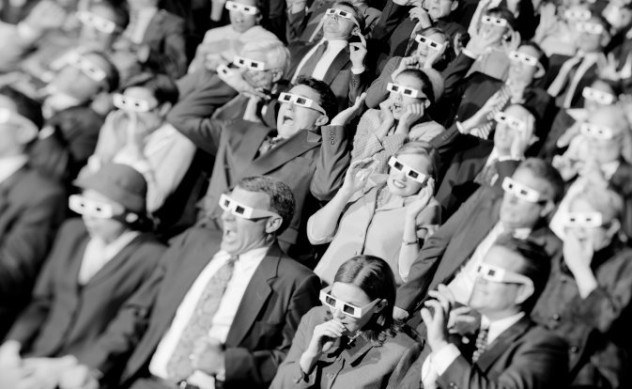 Weird Stuff
Weird Stuff  Weird Stuff
Weird Stuff  Mysteries
Mysteries 10 Tragic Disappearances and Deaths in Joshua Tree National Park
 History
History 10 Ways Childhood Really Sucked in the Old West
 Music
Music 10 Name Origins of Famous Bands from the 1990s
 Religion
Religion 10 Biggest Turnarounds by the Catholic Church
 Weird Stuff
Weird Stuff 10 Unbelievable Times Laws Had Unintended Consequences
 Humans
Humans Ten Historic Women Who Deserve Way More Credit Than They Got
 Movies and TV
Movies and TV 10 Films That Spawned Major Lawsuits
 History
History Ten Times Towns Were Wiped Off the Face of the Earth
 Creepy
Creepy 10 of the Most Disturbingly Haunted Public Houses in the UK
 Weird Stuff
Weird Stuff 10 Niche Subcultures That Are More Popular Than You Might Think
 Mysteries
Mysteries 10 Tragic Disappearances and Deaths in Joshua Tree National Park
 History
History 10 Ways Childhood Really Sucked in the Old West
Who's Behind Listverse?

Jamie Frater
Head Editor
Jamie founded Listverse due to an insatiable desire to share fascinating, obscure, and bizarre facts. He has been a guest speaker on numerous national radio and television stations and is a five time published author.
More About Us Music
Music 10 Name Origins of Famous Bands from the 1990s
 Religion
Religion 10 Biggest Turnarounds by the Catholic Church
 Weird Stuff
Weird Stuff 10 Unbelievable Times Laws Had Unintended Consequences
 Humans
Humans Ten Historic Women Who Deserve Way More Credit Than They Got
 Movies and TV
Movies and TV 10 Films That Spawned Major Lawsuits
 History
History Ten Times Towns Were Wiped Off the Face of the Earth
 Creepy
Creepy 10 of the Most Disturbingly Haunted Public Houses in the UK
10 Surprisingly Progressive Pop Culture Milestones In Film
It’s a common belief that TV and movies only really got their act together in terms of tolerance in the second half of the 20th century. Before that, bigotry and repression were the prevailing attitudes. But it’s not actually quite that simple, with anomalies in art and surprises in permissible content sometimes appearing decades before you’d imagine.
10The First Movies For A Black Audience
When most people think of the first movies made specifically for black audiences, they probably imagine the “blaxploitation” craze of the 1970s. In fact, the African-American film industry dates all the way back to the first decades of the 20th century. Between 1910 and 1950, at least 500 movies were made with majority-black casts. Known as “race movies,” they were usually helmed by black directors and featured African-American heroes in everything from romances to Westerns.
Many of the films included radical themes that caused friction with the censors. For example, Oscar Micheaux’s 1920 epic Within Our Gates tells the story of a Southern woman going north to raise money for a school. She runs into a number of difficulties, including a close call with a careless white motorist. The driver in question offers a donation to make amends but comes under pressure not to donate to the education of black children.
Within Our Gates courted controversy with numerous scenes deliberately inverting the notoriously racist content of D.W. Griffith’s 1915 blockbuster Birth Of A Nation. For example, Birth Of A Nation portrayed “good blacks” as simple-minded and naturally subservient to whites. Within Our Gates includes a similar character—only to have him turn to the camera and lament the oppression that forces him to suck up to whites and engage in minstrel speak. It also portrays a powerful white man who attempts to rape a black woman, reversing a similar scene in Birth Of A Nation. And an attempted lynching is shown as completely evil, a far cry from Griffith’s vision of a heroic KKK. The movie was widely banned, no surprise given that censors like Lloyd T. Binford of Tennessee would ban films for suggesting racial equality as late as the 1950s.
There was also a strong African-American market for Christian movies, of which the films by Spencer Williams are the best known. These include classics like 1941’s The Blood Of Jesus, which tells the story of a woman who is accidentally shot by her atheist husband and has a fever dream about being tempted into sin as a nightclub dancer. That film has since been entered into the National Film Registry for cultural significance.
9The Labor Rights Movie Made At The Worst Possible Time
In 1953, the infamous Red Scare was in full swing and many left-wing Hollywood figures found themselves “blacklisted” and forced out of the movie industry. The year before, a three-year strike by Mexican-American miners in Grant County, New Mexico, had come to an end after considerable threats of violence and many accusations of communism. The strike also saw massive support from the women of the community, who had to maintain the picket line after a court injunction made it illegal for the men to do so.
Meanwhile, director Herbert J. Bieberman had just served six months in prison for refusing to testify in Congress about his political leanings. Instead of keeping his head down, he teamed up with producer Paul Jarrico and screenwriter Michael Wilson to make a film about the strike. In other words, it was a movie written by a blacklisted writer, directed by a blacklisted director, and produced by a blacklisted producer about a union that was considered to have Communist sympathies. Oh, and some of the actors in it were blacklisted, too. The movie might as well have had a personal seal of approval from Joseph Stalin. Unsurprisingly, it proved a difficult shoot, with the lead actress suddenly deported and many film companies refusing to even print the movie.
The resulting film, Salt Of The Earth, is not particularly famous. It has no star power, thanks to a cast of affordable, but believable, non-actors. But it is greatly respected, currently rating 100 percent on Rotten Tomatoes. It definitely still stands as one of the more daring dramas ever made.
8The Precedent-Setting Nudist Film

Naturism (or nudism as it’s more commonly known) was one of those concepts connected with the loosening of acceptable alternative lifestyles and their portrayals in media. It did this, quite accidentally, with a 1954 film called Garden Of Eden, produced by Walter Bibo.
In this drama, a woman leaves her domineering father’s home and finds her way to a local colony of naturalists. In a barely disguised advertisement for the community, the film featured considerable nudity (none of it male) at a time when sexual repression was so pervasive that one woman found herself prevented from seeing it in a theater even though she was 20 years old, with her husband, and was in the movie.
Garden Of Eden wasn’t actually the first naturist film, but it did end up provoking a precedent-setting legal challenge. In his ruling, Judge Sam Driver declared that “nudity per se is not obscene” and that the movie was not about titillation, instead aiming to showcase an alternative way of life for wholesome, decent people. Naturally, this led to a wave of exploitation knockoffs, which made increasingly flimsy claims to be “promoting the nudist lifestyle.”
7The First Feature Film (With Nudity)
Of course, Garden Of Eden was not by any means the first movie to feature nudity that was legally screened to film audiences. In fact, the first movie to feature full frontal male nudity was released all the way back in 1911. And it was arguably the first uninterrupted, feature-length film ever shown.
The film in question was an Italian adaptation of Dante’s Inferno. Certainly no cult exploitation movie, the production was considered so elaborate by the standards of the time that it required three directors just to handle it all. As a result, the special effects hold up surprisingly well today. The film itself mostly consists of various shots of condemned souls being horribly tortured, including naked sinners being whipped by demons.
The film was both the first feature-length Italian movie and the first film of over an hour to be shown in one screening in the US. Previously, it had been thought that people wouldn’t want to sit through a whole hour of film, but apparently the combination of violence and nudity negated those concerns, and the movie was a hit.
6The Film About Integration Made Mid-Integration
Film fans familiar with the name Roger Corman probably know him for cheesy B-movies like Sharktopus and Death Race 2000. His work as producer of 1962’s The Intruder is much less well known, even though it’s by far his most critically celebrated and daring film. Starring William Shatner as Adam Cramer, it’s the story of a rabble-rouser who enters a community called Caxton in an unspecified Southern state. Seizing on local resentment about the newly federally mandated integration of local schools, Cramer begins to gain power by organizing rallies and protests, which he escalates until they threaten to culminate in lynchings of black students on school grounds.
Corman made the daring decision to film the movie in Southeastern Missouri, where many people remained opposed to integration at the time. As a result, the cast and crew received harassment and death threats. They even had to avoid going back to their hotels after shooting a KKK rally because word had gotten out there was a plan to attack them there. Even if the movie had been shot in complete safety, it was still decades ahead of its time, with movies like Mississippi Burning not released until the ’80s. Even critics who didn’t care for the movie itself, like Bosley Crowther of the New York Times, made a point of complimenting the movie for its boldness. Had it only been a successful film, imagine how many more progressive movies Corman might have made.
5The First Anti-War Film
It took no time at all for movies to be used as a tool by governments wanting to motivate their citizens to go to war. For example, the Spanish-American War produced a propaganda film of Americans tearing down a Spanish Flag in Cuba in 1898, only a few years after the first commercial film screening. But the military cooperating with the shooting of an anti-war movie? That’s something you wouldn’t expect a filmmaker to be able to pull off, especially not back in the early 20th century, and certainly not in the middle of one of the deadliest wars ever fought. But French director Abel Gance did it anyway with his 1918 war epic, J’Accuse.
The film is largely a love triangle about two soldiers and the woman they love. One of the soldiers, a poet, seems to hallucinate the French war dead rising from their graves and stumbling home to ask the people who stayed behind if their sacrifice was made in vain. Naturally, this was a very common worry about World War I, although Gance meant it more as an indictment of war in general. Gance was able to give his movie immense depth by filming actual soldiers on leave for the scenes where the dead march. The French army even helped him film footage of the actual war. Perhaps the single most poignant aspect of the whole film is that many of the soldiers who played marching dead men went on to be killed in real life.
4The First Positive Interracial Movie Relationship
In the late 1910s and 1920s, America went through one of its most xenophobic periods. Laws such as the 1924 Immigration Act effectively banned Asians from emigrating to the United States. So it’s surprising that 1919 saw the release of Broken Blossoms, the first film to feature a positive interracial relationship, in this case between a white woman and an Asian man. Casual film fans might be quite surprised to learn that the movie was directed by D.W. Griffith, the director of the enormously influential (and racist) pro-KKK film Birth Of A Nation. In fact, Broken Blossoms seems to have been part of a career-long attempt to redeem himself after Birth Of A Nation by making anti-racist movies like Broken Blossoms and Intolerance, even though Birth Of A Nation had demonstrated how lucrative pandering to bigots could be.
By today’s standards, Broken Blossoms is not politically correct. The Asian lead character, Cheng Huan, is played by a white man and is referred to in the narration as “the yellow man.” But Huan is a sympathetic character who went to America hoping to teach pacifist Buddhism and seeks to help his love interest, Lucy, escape an abusive home. That was an infinitely more progressive image than the Fu Manchu bigotry plaguing Asian-Americans at the time. Despite the climate in which it was made, Broken Blossoms became a huge hit, although it clearly failed to significantly reform wider race relations.
3The Simpsons Have The First Gay Kiss On Network TV
The first kiss between a gay couple on Network TV came during a 1991 episode of L.A. Law. But, as with so many other things, it could be argued that The Simpsons did it first. In season two of the immortal series, the 1990 episode “Simpsons And Delilah” features Homer Simpson growing thick hair and almost automatically becoming an executive as a result. He is taken under the wing of Karl, voiced by gay icon Harvey Fierstein. After Homer loses his hair again, Karl makes a doomed attempt at a motivational speech, culminating with a kiss on the lips and a slap on the butt.
So how was this milestone event received? Well, much to Matt Groening’s annoyance, nobody really seemed to notice, probably because it was played as a joke and Homer clearly didn’t reciprocate any feelings Karl may have had. The Simpsons actually did cause significant controversy at the time, but it mostly centered around such innocuous material as Bart Simpson being a troublemaker or merchandise that said “Underachiever and proud of it!” It was years before the 1994 episode of Roseanne where Roseanne kissed a lesbian, which was considered so shocking that ABC felt the need to put a parental disclaimer up first. Who can tell what will compel people to protest sometimes?
2The First Openly Pro-Gay Movie
So if it took until the ’90s for the first gay kiss on TV, you’d assume that pro-gay films must also have been a relatively recent development. But the first movie advocating for the rights of homosexuals actually dates all the way back to 1919. Telling the story of a violin teacher who is blackmailed with the threat of exposing his sexual orientation to the world, Different From The Others was the first movie where the voice of reason condemned homophobia instead of homosexuality. In fact, the German movie even includes a sexologist who explains that homosexuality is not harmful or a disease.
Between Different From The Others and Broken Blossoms, 1919 was an anomalously progressive year for movies, particularly since Different From The Others was banned as soon as 1920 rolled around. Unsurprisingly, the Nazis made a point of trying to destroy the movie. Sadly, they were successful enough that only 50 minutes of the film survive today. In 2013, a Kickstarter campaign funded a restoration, which used scripts, notes, and photographs to create the best approximation of the original possible with the surviving materials.
1The First Surviving Movie With A Black Cast
The earliest surviving movie with an almost exclusively black cast (there are a few white extras) is an unfinished 1913 comedy called Bert Williams Lime Kiln Club Field Day (presumably it was a working title). Starring Bert Williams, a hugely popular African-American comedian of the time, the movie follows him as he fends off romantic rivals on a day out with his lady. Unsurprisingly, the movie ends with Williams getting the girl and marrying his love interest.
Despite the progressive casting, the film can seem odd to modern eyes, most noticeably because Williams spends the entire movie in blackface, In fact, he’d been been doing that for years as part of a wildly successful double act called “Two Real Coons,” which promised to be more authentic than any other blackface act (since the performers were actually black). George Walker, the other half of the double act, explained it best: “We thought that as there seemed to be a great demand for black faces on the stage, we would do all we could to get what we felt belonged to us by the law of nature.” Although the movie has a few racially offensive jokes, Museum of Modern Art curator Ron Magliozzi, who rediscovered the movie in 2014, theorized that it probably wasn’t completed and released because it “wasn’t racist enough” for the era.
Dustin Koski’s Twitter feed will probably soon be considered a progressive pop culture milestone.








